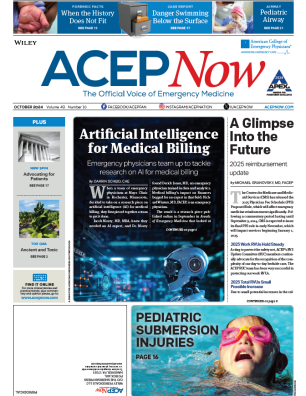What, then, is the emergency physician’s responsibility?
Explore This Issue
ACEP News: Vol 32 – No 10 – October 2013Physicians are charged with the duty of advancing the health-related interests of their patients, known as the physician’s fiduciary obligation. The prevention of violence and the establishment of a safe environment are in the best health interest of both patients and staff in the emergency department. However, the provision of high quality health care is also a fiduciary obligation. Health care providers must not allow the strongly negative personal feelings that an aggressive patient may evoke to undermine their provision of the best care possible.
It is in the tension between being a victim and being an unbiased caregiver and noncombatant that the emergency physician’s professional virtues come into play.
Professional virtues are cultivated character traits that empower physicians to “discern and discharge moral obligations to patients.”
The virtue of impartiality is exhibited when these patients are treated with an objectivity that transcends the natural hostility and anger that personal aggression ignites. The virtues of courage and self-sacrifice allow emergency physicians to assume the leadership role and even take personal risks to provide “steadfast care” for violent patients.1
When considering the consequences of violence, emergency physicians must think about physical, emotional and legal consequences of violence and what outcomes may transpire if it is not prevented through the use of trained personnel, appropriate policies, and timely interventions. How can emergency physicians prepare themselves both morally and technically for the prevention and management of violence? To begin, emergency physicians can set the standard for other emergency department staff to be aware of this problem, to identify it as unacceptable, to know hospital policy, and to promote and participate in education programs.1
In addition, there is a great deal of research to be done and knowledge to be gained about how best to reduce violence in emergency departments. Incidents of violence often go unreported.2,3,4
This makes them difficult to study, so it is not surprising that few interventions have been prospectively investigated.4 Likewise, the reasons health care workers fail to report incidents of violence are inadequately studied, but may include institutional factors and/or worker stigma associated with filing complaints or calling police to the emergency department. Failure to report may also be related to the serious consequences anticipated for the violent patient charged with assault.
Many intoxicated patients believe that violence against health care workers will go unpunished. They are confused about what constitutes criminal behavior during an emergency department visit. Early on, patients demonstrating escalation of bad behavior (swearing, spitting, self-injurious) need to hear a clear message from their providers. Physically assaulting emergency care providers may be a felony under locally applicable law. A felony count may be punishable by a fine, imprisonment, or both.
Pages: 1 2 3 4 | Single Page





No Responses to “ED Violence: Not Just Part of the Job”